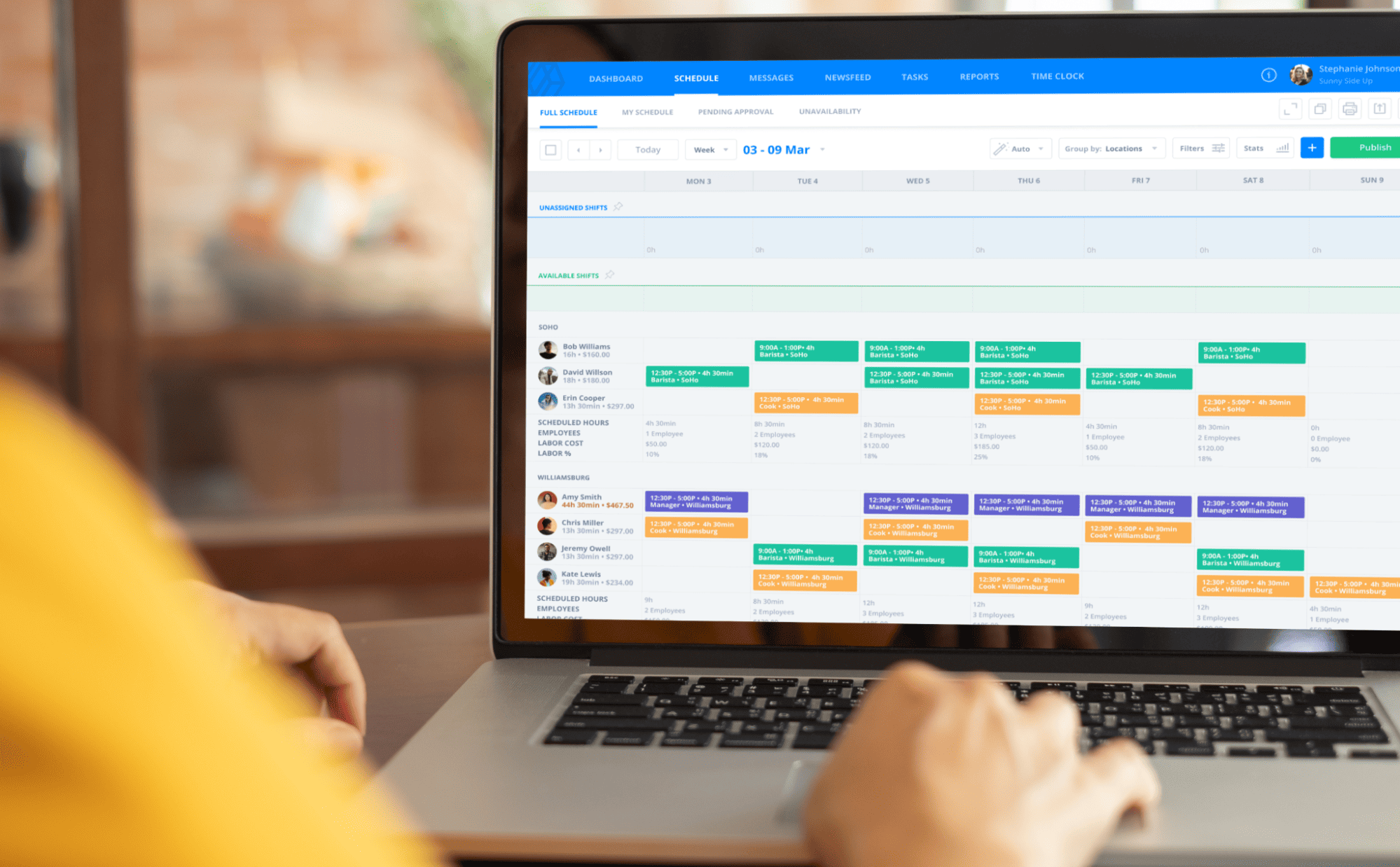Staffing and Scheduling: Differences Managers Need to Know
Knowing the difference between staffing and scheduling helps managers make good ...

For organizations that run around the clock, shift scheduling is vital for smooth operation. That type of scheduling, though, can pose significant challenges for administration and employees alike. One popular solution is the 2-2-3 schedule.
In this article, we’ll explain how the 2-2-3 schedule works, consider its pros and cons, and offer tips to make the implementation and operation go smoother.

The 2-2-3 schedule is a shift scheduling system for maintaining 24-hour, seven-day-a-week employee coverage.
The system balances out long employee shifts with regular two- or three-day periods of time off and a fair distribution of night shifts.
In the 2-2-3 schedule, the workforce is divided into four teams, each on a four-week (28-day) rotation.
In the first week of their rotation, a team will work two 12-hour day shifts, followed by two days off, followed by three more 12-hour day shifts. The second week begins with two days off, followed by two day shifts, and then three more days off.
The third and fourth weeks of the rotation follow the same sequence of working days and off days, but with night shifts replacing day shifts. After the fourth week, the rotation begins again.
This means employees will always have a week in which they work five days followed by a week in which they work only two days.
The rotations of the other three teams follow the same pattern, but offset from each other to maintain around-the-clock coverage each week.
For example, during the week that Team A works five day shifts, Team B will work five night shifts. During the two days of the week that Teams A and B are off, Team C will handle the day shift while Team D is at work during the night.
The classic 2-2-3 schedule following this pattern is also sometimes called the “Panama schedule,” although the origins of the name are unclear.

As we mentioned, the 2-2-3 schedule is a shift work system designed for situations where it’s absolutely vital to maintain a certain level of employee staffing at all times.
Police, firefighters, and paramedics often use the 2-2-3 schedule or a variation of it because of the need to provide a prompt and effective response to emergency calls that could come in at any moment.
However, many private sector businesses now provide support for a globally distributed customer base and have also adopted the 2-2-3 schedule.

Although employees work long shifts in the 2-2-3 schedule, they also get plenty of time off to recover. Employees never work more than three days in a row, followed by two- or three-day “weekends,” and only work a total of about 180 days in a year.
In most organizations, few employees will be eager to work overnight shifts. The 2-2-3 schedule removes any dispute about unfairness in who gets assigned to work nights by ensuring all employees are assigned the same number of night shifts each rotation.
There’s no getting around it: Working 12-hour shifts has been proven to have negative effects on employee well-being. Overnight shifts in particular have been linked to poor sleeping patterns, higher stress, and health issues.
The 2-2-3 schedule can work very well when you have enough staff to fill every team and shift. But any shortfall in staffing throws off its perfect balance. This makes adapting to employee vacations or call-outs due to illness or emergencies problematic.
If you think that the 2-2-3 schedule could be a good fit for your business, here are some tips for implementing the process in a way that maximizes productivity and minimizes employee turnover.

Effective communication with employees is essential no matter what type of scheduling paradigm your company uses.
Before you put the 2-2-3 schedule into practice, take time to explain how the system works. Integrate employee preferences on team composition if possible. Make sure that new employees understand the schedule during the interview and onboarding process.
Post the team rosters and schedules well before the date they go into effect. If you need to make changes, notify everyone with plenty of advance notice.
Scheduling software like Sling allows your employees to check the schedule anywhere, anytime. It also lets you broadcast announcements and changes so your staff isn’t caught off guard.
If you’re implementing a 2-2-3 schedule for the first time or new employees are joining a team that is already working such a schedule, it’s a good idea to provide guidance on how to make the transition.
This is especially important if members of your team have never worked a night shift.
Consider writing instructions that give night-shift workers advice on how to eat, when to take breaks, when to go to bed, and other lifestyle choices that can impact their work.
Post those instructions in your employee handbook so everyone can access them when they need them.
Another way to help new team members adapt and adjust to the 2-2-3 schedule is to assign them to an experienced coworker who can act as a mentor and guide until the new team member gets things figured out.
The 2-2-3 schedule is based on 12-hour “day” shifts and 12-hour “night” shifts. Many guides on the 2-2-3 schedule assume that the day shift is 7 a.m. to 7 p.m. and the night shift is 7 p.m. to 7 a.m. However, this isn’t set in stone.
There is no requirement on the specific blocks of time you treat as “day” and “night.” Consider your business needs and employee preferences to determine the ideal time for your shift changeover.

Regular, restful breaks are critical during long shifts on the 2-2-3 schedule, especially the night shifts. Breaks help keep productivity high and prevent staff from getting burned out.
Consider specifically scheduling break times during each shift. The purpose of this isn’t to make employees feel they must stay at their desks at all other times regardless of workload, but to ensure that employees who tend to get caught up in tasks actually take breaks.
A break doesn’t mean much if employees don’t have anywhere to get away from work, though. Invest in comfortable break spaces for your employees, and consider including a place for them to take a brief “power nap.”
The lighting you choose for your workplace can have a direct effect on the energy level, productivity, and overall mood of your employees. This is especially true for those working the night shift portion of the 2-2-3 schedule.
Lighting that is too dim may make your employees feel tired and cranky. Lighting that is too bright may disrupt their body’s natural circadian rhythms and even trigger headaches.
Lighting that is just right for the shift and the space can help your team members stay alert and energized even when they’re on the tail end of a 12-hour work day.
Take the time to examine your team’s workspace or hire a professional to conduct a survey.
In the process, answer questions such as:
Is there enough existing light to, at least, meet minimum United States General Services Administration (GSA) standards?
Can you improve on the existing arrangement? Does glare become a factor at any position in your workspace?
Do team members complain about eyestrain? Would task lighting fill in the gaps? Do lights flicker in places?
As you look around your business, consider the type of light that would work best in the space (options include direct, direct-indirect, indirect, and shielded).
It can also be beneficial to consider bulb type, such as fluorescent, light-emitting diode (LED), halogen, or incandescent, as well as the color and temperature of light they emit.
In general, warm yellow or warm orange lights are better for relaxing and unwinding, while cool blue or cool white lights are better for waking up, working, and concentrating.
Keep in mind that new technologies allow you to set the system so that the lighting changes automatically from the cooler greens and blues that occur in the morning to the warmer yellows and reds that occur in the afternoon.
This lets you vary the color temperature of your workplace lights to mimic what happens outdoors. Such natural light can help improve your employees’ moods and focus so that they are able to stay productive for longer periods of time.of your workplace lights to mimic what happens outdoors. Such natural light can help improve your employees’ moods and focus so that they are able to stay productive for longer periods of time.

Twelve-hour shifts can be difficult for even the healthiest, most experienced team members, and many of your employees may rely on coffee, soda, or energy drinks to get them through.
But consuming caffeine as far out as six hours before bed can disrupt their body’s natural rhythms to the point that they may not be able to sleep when they need to.
That can lead to all sorts of problems for those working the 2-2-3 schedule, including depleted energy levels, loss of focus, irritability, and burnout.
To combat the overuse of caffeine, you may consider encouraging your team members to avoid caffeinated beverages during the last six hours of their shift.
They can certainly have caffeine at the start of their shift, but they may want to switch to water or other non-caffeinated beverages in the middle of their shift and for their remaining time on the job.
Similarly, eating high-sugar foods too close to bedtime can also disrupt the sleep-wake cycle anSimilarly, eating high-sugar foods too close to bedtime can also disrupt the sleep-wake cycle and cause problems for those working the 2-2-3 schedule.
You can’t dictate what your employees eat during their time on the job, but, as part of the guidance you give them in your employee handbook, you can suggest switching to whole foods during the second half of their shift.
Whole food options include fresh fruit (e.g., apples, bananas, peaches, oranges, etc.), fresh vegetables (e.g., carrots, spinach, celery, lettuce, sweet potatoes, etc.), lean protein (e.g., fish, chicken, beans, etc.), grains (e.g., oats, rice, quinoa, etc.), nuts and seeds (e.g., almonds, pecans, pistachios, sunflower seeds, etc.).
Minimally processed foods like these provide plenty of energy for the day’s (or night’s) work without the inevitable “crash” that comes after consuming pre-packaged, high-sugar, processed foods that may be common in the workplace.
For managers, making and revising schedules can eat up a large amount of time. Using employee scheduling software automates a huge part of the process so you can attend to other tasks.
Sling, for example, offers an intuitive drag-and-drop interface and lets you create and save schedule templates to save time. You’ll be able to manage time-off requests and availability changes and have clear visibility of who’s working when, even across multiple locations.
Using software can streamline the process of implementing a 2-2-3 schedule at your organization and help you keep your business running smoothly, shift after shift.

The 2-2-3 schedule is a popular choice for organizations that have to respond to customer needs or emergencies 24/7.
It has the advantages of offering employees ample time off and equitable assignment of less-desirable night shifts, but managers must take care to address the physical and mental fatigue that long shifts and overnight shifts can have on staff.
Whatever business you’re in and whatever type of schedule you use, Sling can save you time, improve efficiency, and help your team communicate.
To find out more about how our powerful scheduling, timekeeping, and task management features can transform your organization, visit GetSling.com today.
See Here For Last Updated Dates: Link
This content is for informational purposes and is not intended as legal, tax, HR, or any other professional advice. Please contact an attorney or other professional for specific advice.
As a general rule, certain industries will use the 2-2-3 schedule to provide continuous, 24/7 employee coverage.
Those industries and businesses include healthcare (hospitals, urgent care facilities, and emergency rooms), manufacturing and production, law enforcement and public safety, fire departments and emergency services, utilities and energy providers, and call centers.
Yes, 2-3-2 and 3-2-2 often refer to variations of the 2-2-3 schedule.
The 2-3-2 and 3-2-2 consist of the same underlying two-week repeating schedule of work and time off. In the 2-3-2, employees or teams get two days on, three days off, and two days on. In the 3-2-2 schedule, employees or teams get three days on, two days off, and two days on.
Regardless of the sequence used, all three schedules provide similar coverage and days off over a longer cycle.
A traditional workweek consists of eight-hour shifts every Monday, Tuesday, Wednesday, Thursday, and Friday (with Saturday and Sunday off). This results in 40 hours total for the week.
The 2-2-3 schedule consists of 12-hour shifts over a two-week period that results in 48 hours over 14 days.
The 2-2-3 schedule offers longer stretches of free time and consistent breaks within the cycle, which can lead to better work-life balance compared to the traditional workweek.
Schedule faster, communicate better, get things done.